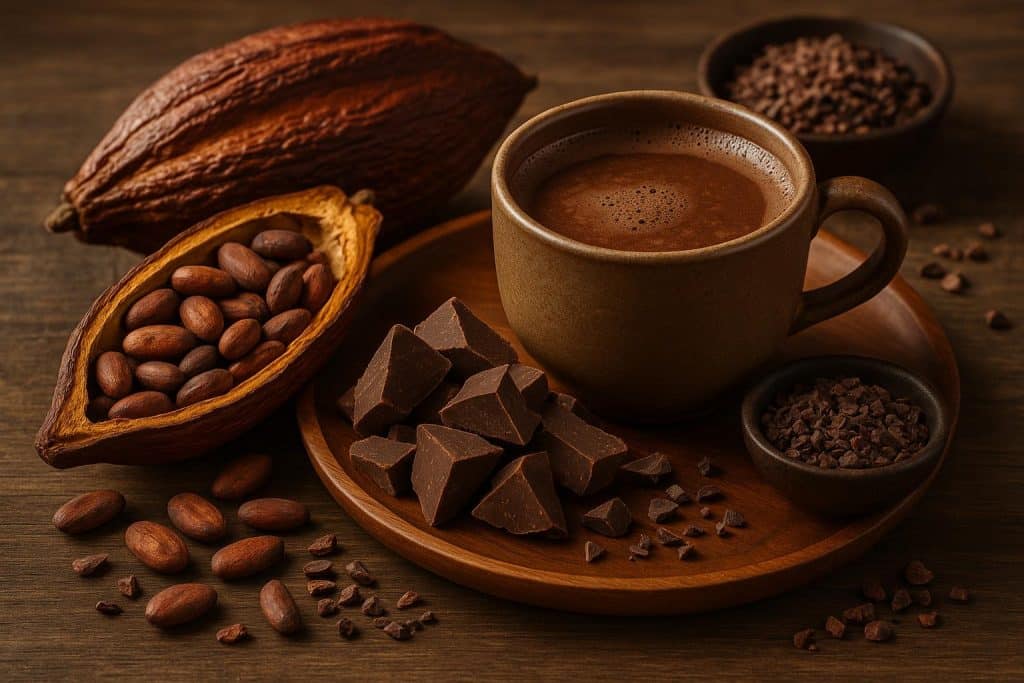In our exploration of ancient traditions, it becomes clear that ceremonial cacao holds a status far beyond that of a mere indulgent beverage. We refer to it as “The Food of the Gods”, a phrase steeped in mythology, culture and botanical honour. This distinction is not accidental: the very scientific name of the cacao tree, Theobroma cacao, means “food of the gods” in Greek.
In this article we examine why ceremonial cacao has earned this exalted title—through myth, ritual, nutrition and modern revival.
The Etymology: Theobroma Cacao and Its Divine Name
The botanical name of the cacao tree holds the first key to understanding this elevation. The genus name Theobroma derives from the Greek words theos (god) and broma (food). Thus, Theobroma cacao literally translates as “food of the gods.”
This naming reflects both a scientific recognition of the plant’s worth and a nod to the spiritual reverence it has historically commanded. The fact that botanists adopted such a powerful phrase underscores how cacao’s significance transcends simple agriculture.
Ancient Cultural Roots: Mayan and Aztec Reverence
Mayan Tradition and Mythology
For the ancient Maya civilization, cacao was regarded as a sacred gift. The Mayan sacred book, the Popol Vuh, includes references to cacao emerging from the sacred mountains of creation.
Cacao was consumed during weddings, funerals and ritual events; it was even placed in tombs to nourish the soul in the afterlife.
The Mayan deity Ek Chuah served as the patron of cacao and merchants, emphasising the crop’s deep spiritual and economic value in Mayan society.
Aztec Usage and Symbolism
Similarly, the Aztec culture held cacao in the highest regard. The beans served as currency, tribute and ritual offering—so precious that common use was restricted.
In Aztec cosmology, the feathered serpent god Quetzalcoatl is said to have bestowed cacao upon humanity, reinforcing its divine origin.
Why “Food of the Gods”? The Layers of Meaning
Sacred Gift and Ritual Offering
Cacao was used as a sacred offering in temple rituals. Vessels filled with cacao drinks have been found in archaeological sites, linked to priestly ceremonies and religious events.
This ritual use laid the foundation of cacao’s divine status—if the gods are being offered something, that something must be worthy of a divine realm.
Symbolism of Life, Death and Transformation
Cacao held symbolic associations with life, blood and the earth in Mesoamerican thought. Some Mayan depictions show gods emerging from cacao pods, or cacao associated with human creation myths.
The very transformation of the bean—from tree fruit to fermented seed to drink—mirrored themes of life cycles and spiritual rebirth.
Exceptional Quality, Rarity and Value
Practically speaking, cacao beans grew only in certain regions under specific conditions. Their rarity and difficulty of cultivation meant that they were precious.
When something is rare, well-regarded and tied to ceremony, it gains value beyond ordinary consumption—hence the label “divine”.
Nutritional and Psycho-active Effects
Modern research shows cacao is rich in flavonoids, magnesium, theobromine and other compounds that can stimulate mood, energy and wellbeing.
While ancient peoples may not have understood the precise chemistry, they certainly appreciated the lift cacao gave warriors, priests and ceremonial participants.
What Makes Ceremonial-Grade Cacao Unique
Minimal Processing, Preserved Potency
The term ceremonial cacao refers to cacao that is minimally processed—often made from rare or heirloom varieties, lightly roasted or even raw, retaining much of the bean’s natural composition.
These preparations are closer to what ancient peoples consumed when they viewed cacao as sacred.
Ritual Preparation and Intention
During a cacao ceremony, participants often share the drink in a sacred space, set an intention, and engage in meditation, breathwork or music.
This elevates consumption from everyday habit to spiritual experience—again echoing the “food of gods” status.
Ethical Sourcing and Respect for Traditional Cultures
Modern ceremonial cacao movements emphasise respect: sourcing from indigenous growers, recognising historical stewardship and avoiding cultural appropriation.
This approach honours the origins of cacao and keeps alive its elevated status by aligning it with integrity and sacred care.
The Modern Revival: Why It Still Matters
We are witnessing a resurgence in interest for ceremonial cacao—not just as chocolate, but as a ritual catalyst, wellness tool and community experience. Studios, wellness retreats and conscious communities worldwide host cacao ceremonies drawing on ancient traditions.
In a world inundated with processed foods and stress, the idea of a simple bean—fermented, grounded, shared—that can open the heart and connect us to our ancient past has strong appeal.
How to Experience Ceremonial Cacao with Reverence
- Select true ceremonial-grade cacao: look for minimal processing, single-source beans, traditional producers.
- Prepare mindfully: heat the cacao gently (avoid boiling), stir with intention, set a heartfelt purpose.
- Create sacred space: whether alone or in company, take a moment for silence, breath, connection.
- Honor the origins: be aware of the cultural lineage of the cacao—its roots among Maya and Aztec peoples—and purchase ethically.
Closing Thoughts: Why “Food of the Gods” Still Resonates
When we call ceremonial cacao “food of the gods”, we are acknowledging more than flavour or indulgence. We are honouring millennia of ritual, deep spiritual connection, ancient myths and living cultures. We are recognising that this humble seed has journeyed from rainforest to altar to modern café, yet still carries within it the memory of what it once symbolised.
In enjoying ceremonial cacao with awareness, we don’t just drink it—we partake in a tradition. And in doing so, we connect with the divine.
